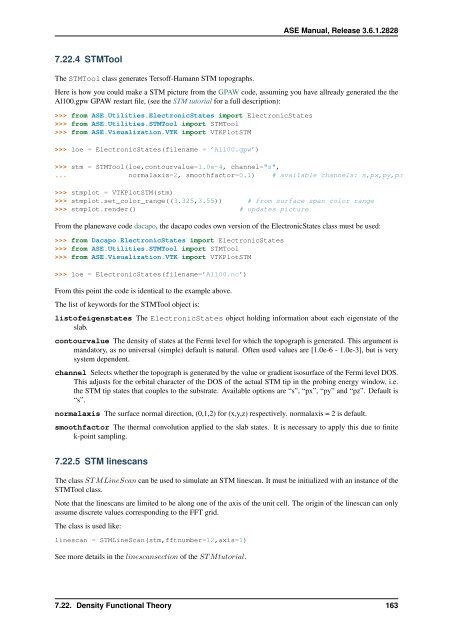ASE Manual Release 3.6.1.2825 CAMd - CampOS Wiki
ASE Manual Release 3.6.1.2825 CAMd - CampOS Wiki
ASE Manual Release 3.6.1.2825 CAMd - CampOS Wiki
Create successful ePaper yourself
Turn your PDF publications into a flip-book with our unique Google optimized e-Paper software.
7.22.4 STMTool<br />
The STMTool class generates Tersoff-Hamann STM topographs.<br />
<strong>ASE</strong> <strong>Manual</strong>, <strong>Release</strong> 3.6.1.2828<br />
Here is how you could make a STM picture from the GPAW code, assuming you have allready generated the the<br />
Al100.gpw GPAW restart file, (see the STM tutorial for a full description):<br />
>>> from <strong>ASE</strong>.Utilities.ElectronicStates import ElectronicStates<br />
>>> from <strong>ASE</strong>.Utilities.STMTool import STMTool<br />
>>> from <strong>ASE</strong>.Visualization.VTK import VTKPlotSTM<br />
>>> loe = ElectronicStates(filename = ’Al100.gpw’)<br />
>>> stm = STMTool(loe,contourvalue=1.0e-4, channel="s",<br />
... normalaxis=2, smoothfactor=0.1) # available channels: s,px,py,pz<br />
>>> stmplot = VTKPlotSTM(stm)<br />
>>> stmplot.set_color_range((3.325,3.55)) # from surface span color range<br />
>>> stmplot.render() # updates picture<br />
From the planewave code dacapo, the dacapo codes own version of the ElectronicStates class must be used:<br />
>>> from Dacapo.ElectronicStates import ElectronicStates<br />
>>> from <strong>ASE</strong>.Utilities.STMTool import STMTool<br />
>>> from <strong>ASE</strong>.Visualization.VTK import VTKPlotSTM<br />
>>> loe = ElectronicStates(filename=’Al100.nc’)<br />
From this point the code is identical to the example above.<br />
The list of keywords for the STMTool object is:<br />
listofeigenstates The ElectronicStates object holding information about each eigenstate of the<br />
slab.<br />
contourvalue The density of states at the Fermi level for which the topograph is generated. This argument is<br />
mandatory, as no universal (simple) default is natural. Often used values are [1.0e-6 - 1.0e-3], but is very<br />
system dependent.<br />
channel Selects whether the topograph is generated by the value or gradient isosurface of the Fermi level DOS.<br />
This adjusts for the orbital character of the DOS of the actual STM tip in the probing energy window, i.e.<br />
the STM tip states that couples to the substrate. Available options are “s”, “px”, “py” and “pz”. Default is<br />
“s”.<br />
normalaxis The surface normal direction, (0,1,2) for (x,y,z) respectively. normalaxis = 2 is default.<br />
smoothfactor The thermal convolution applied to the slab states. It is necessary to apply this due to finite<br />
k-point sampling.<br />
7.22.5 STM linescans<br />
The class ST MLineScan can be used to simulate an STM linescan. It must be initialized with an instance of the<br />
STMTool class.<br />
Note that the linescans are limited to be along one of the axis of the unit cell. The origin of the linescan can only<br />
assume discrete values corresponding to the FFT grid.<br />
The class is used like:<br />
linescan = STMLineScan(stm,fftnumber=12,axis=1)<br />
See more details in the linescansection of the ST Mtutorial.<br />
7.22. Density Functional Theory 163












